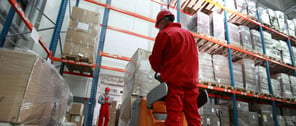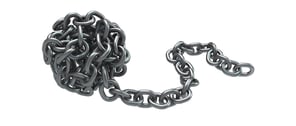The balance of power is shifting in the shipping industry — customers are no longer at the mercy of the shipper. Multiple modes of transportation, several freight forwarders, and a complete loss of visibility and control after the first mile — these are some of the multimodal shipment tracking challenges that customers can now tackle head-on thanks to revolutionary solutions in the IoT-enabled supply chain tracking space.
Recently, a container ship traveling from Sines, Portugal to Bremerhaven, Germany lost over 200 containers in the sea owing to bumpy weather.
Though containers going overboard is not always a possibility, the point is, there are in fact several things that could go wrong with your shipment, which makes staying on top of things essential.
But when it comes to tracking a multimodal shipment, there are only three things you can know accurately — when the shipment leaves the facility, where your vessel or airline is, and when (or whether!) it reaches the destination.
You have no visibility of the first mile, last mile, whether your shipment is on the carrier, and its condition.
The only way you can get any information on your cargo is from the freight forwarders at the top and bottom of the supply chain; holistic in-transit monitoring is out of the question.

No! And we don’t blame them.
Even though your best freight forwarder has a much better idea about the shipment than you do, their connectivity with the shipment is restricted to the first and last mile, that too limited to the part where they can tell you if the cargo has left, is on a carrier, or has reached the destination.
The biggest challenges faced by an intermodal freight forwarder — that limit their ability to track the shipment with precision — are usually a combination of the following:
- Your cargo is not their only business: Your freight forwarder handles a lot of other jobs besides your shipment. It includes handling complicated things like infrastructural gaps in transportation, legal and port-specific regulations, documentation, terminal operators, shippers, owners and operators of infrastructure and transportation facilities, and sometimes a bigger shipment than yours.
- They rely on consolidation: Although consolidated shipments — wherein your forwarder combines individual shipments from different shippers into a single consignment to access better rates — are beneficial to both the freight forwarder and the customer, it could easily contribute to delays.
- Cost minimization can lead to inefficiency: In order to meet the customer’s cost efficiency expectations, the freight forwarder might sometimes end up missing the larger picture — the overall supply chain efficiency.
- Lack of first & last mile visibility: Most of the time, your Multimodal Transport Operator (MTO) lacks full visibility into the first mile and last mile. Even if they do have some visibility into one or both, it's usually unverifiable and thus unreliable.
- Subcontracting could act as a barrier to modal shift: In the process of transporting your goods, the MTOs sometimes involve other consolidators in the chain of custody. Such subcontracting ultimately means that the tracking information your MTO is relying on is second-hand, which makes you the receiver of third-hand information, meaning obvious slip-ups.
- Parcel-level alienation: Your forwarder doesn’t have verifiable package-level visibility. This means that at any point during the transit or transfer, one or more of your packages in an LTL cargo could be left behind without any trace and you would have no clue.
Getting visibility is hard, especially so when dealing with multimodal/intermodal freight forwarding, since you can’t rely on the carrier because there are several of them involved.
Even if you figure out a way to track the first mile, last mile, and the long haul, it is usually not at package level. Moreover, if it’s a condition-sensitive cargo and disruption takes place, an inventory shortfall is around the corner.
Is It Really That Difficult to Keep Things on Track?
The answer is — It was, but not anymore.
It might seem really complicated to track cargo that’s between modes of transport and has every chance of getting waylaid, but it isn’t that hard in the age of IoT.
Once you set up an item-level tracking system that uses IoT and doesn’t require your transporter’s involvement, it would be simpler than ever to monitor your goods at any point throughout their journey.
You need an IoT-enabled tracking system, one that works independent of your transporter, truck, or carrier, and one that monitors more than location. One that enables you to not only plan your supply chain based on real happenings, but also enables you to address it in real time; one that can work even when there is no network.
Really! What is this ‘one’? Well, it is not ‘one’, but a combination of a few critical elements coming together in an IoT solution. They are:
- Use of portable sensor devices: Attach IoT-based wireless (and wire-free) tracking devices — that go everywhere with your shipment, covering the first mile, long haul, and last mile — to be constantly aware of your shipment’s whereabouts in real-time. These are portable devices that travel with your assets like a best friend no matter where they go, working independent of your transporter, truck, or carrier.
Make sure the devices have long battery life for the long haul and extended cargo hold times, and constant cloud connectivity for data backup. - Condition being as important as location: For food, pharma, or fragile packages sensitive to temperature or shock, ensure that you have the right condition sensors; Bluetooth Low Energy (BLE) based sensor beacons can provide you with package-level location and condition visibility when combined with a GSM hotspot.
- Consolidated visibility when on air or sea: When out of network, the sensors must continue to work. But what happens to location? This is where integration of systems become important. You need a single window dashboard that can still provide you with the location of your consignment when on a vessel or in the air. Good IoT systems come with these features.
- Integration with existing ERP: Make sure that the solution has an API that can be seamlessly integrated with your existing ERP system. This is essential in order to get actionable insights through end-to-end visibility fed in at an enterprise level.
- Alerts that enable timely action: Customized alerts that reach the right people in the right time could save small slip-ups in the supply chain from turning into big losses in the last mile. Full visibility into your shipment would only be useful if timely action on anomalies saves the day. When combined with your ERP, this can enable org-wide orchestration.
- A 24x7 control tower that coordinates everything: Set up a 24x7 control tower that combines all the live data with predictive analytics, so that you can choose the best course of action with the information you receive from the device.
Such a system would be well-equipped to handle LTL and FTL shipments equally well. And the best part about having an IoT-based real-time tracking system — independent of anyone else including the forwarder — is that it will make it easier for you to streamline your process and take proactive actions.
And what would be a better way to make sure your freight carrier meets the SLA without you having to check on them manually?
This Capex-based setup would be your most worthwhile investment to make sure first mile inefficiencies don’t cascade into last mile disasters. Moreover, having full visibility into your assets throughout the multimodal arrangement is a supply chain bliss!













